by Ashutosh Jogalekar
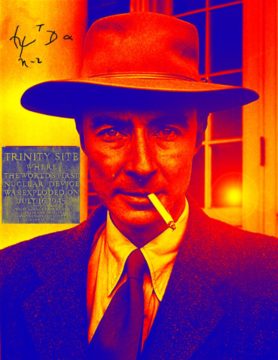
This is the fifth in a series of essays on the life and times of J. Robert Oppenheimer. All the others can be found here.
Between December, 1941, when the United States entered the Second World War and July, 1945, when the war ended and two revolutionary weapons had been used against Japan, Robert Oppenheimer underwent an astonishing transformation that stunned his colleagues. From being an ivory tower intellectual who quoted French and Sanskrit poetry and who had led nothing bigger than an adoring group of graduate students and postdocs – not even a university department – he became the successful leader of the largest scientific and industrial enterprise in history, rubbing shoulders with cabinet secretaries and generals and directing the work of tens of thousands of individuals – Nobel laureates and janitors, physicists and chemists and mathematicians, engineers and soldiers and administrative staff. One cannot understand this transformation without tracing its seed back to momentous scientific and political world events in that troubled decade of the 1930s. I can barely scratch the surface of these events here; there is no better source that describes them than Richard Rhodes’s seminal book, “The Making of the Atomic Bomb.”
In December, 1938, working at the Kaiser Wilhelm Institute in Berlin, chemists Otto Hahn and Fritz Strassman found that uranium, when bombarded by neutrons, split into two small, almost equal fragments, a process that came to be called nuclear fission. This transformation was completely unexpected – the atomic nucleus was thought to be relatively stable. While physicists had bombarded elements with neutrons since the discovery of the elementary particle in 1932, all they had seen was the chipping off or building up of nuclei into elements one or two places above in the periodic table; the breaking up of uranium into much smaller elements like barium and xenon was stunning. When Hahn wrote his colleague Lise Meitner – an Austrian Jewish physicist in exile in Sweden – and her nephew Otto Frisch about this result, the two physicists prophetically figured out on a hike that the process would release energy that could be explained by Einstein’s famous equation, E =mc^2. When uranium breaks up, the two resulting pieces weigh slightly less than the parent uranium – that tiny difference in mass translates to a huge difference in energy according to Einstein’s formula. How huge? Several million times more than in the most energetic chemical reactions.
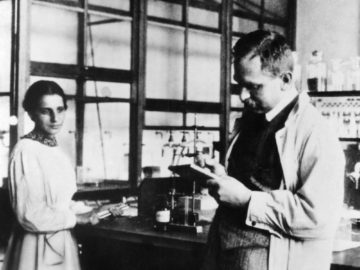
When Frisch confirmed Hahn and Strassman’s experiment he communicated the news to Niels Bohr. Bohr smacked his forehead, saying. “Oh, how can we all have been so foolish! Oh, that is exactly how it should be.” More than anyone else the Danish physicist should have known – he had been the intellectual godfather of the entire generation of physicists who developed quantum mechanics and nuclear physics, and as much as anyone else, he had been confused by a whole mass of irregularities that had emerged during the bombardment of various elements over the previous years; fission could now explain so many of these anomalous observations. Bohr had been leaving for the United States with his assistant, Leon Rosenfeld, for a conference in Washington DC when Frisch told him the news. A blackboard was duly installed on his ship for him to work out the details.
The conscientious Bohr intended on giving Frisch publication priority for the discovery, but news of the discovery was unwittingly leaked to the physicist John Wheeler at Princeton by Rosenfeld. Wheeler in turn communicated it to his journal club, and from there fission spread like wildfire, most notably to the one man who would be both most interested in it and most capable of harnessing it – Enrico Fermi at Columbia University. The Italian physicist had used the excuse of receiving a Nobel Prize in 1938 to emigrate to the United States from Mussolini’s fascism because his elegant wife Laura was Jewish. He had become the world’s foremost authority in neutron physics; it would turn out that he had come very close to discovering fission himself a few years ago. Fermi quickly grasped the momentous implications – shortly thereafter a colleague found him staring out of his window at New York City below. “A small bomb like that”, he said, cupping his hands and looking at the hustle and bustle, “and it would all disappear.” Fermi soon made measurements of the process with his student Herbert Anderson and confirmed the energy release. They also confirmed perhaps the most ominous fact about fission, first discovered by Frisch, that an atom of uranium, when struck by one neutron, would fission and release more than one neutron – a chain reaction. Similar observations were rapidly confirmed the same month by scientists at the Carnegie Institute in Washington during the Washington Conference that Bohr attended and by Irene and Frederic Joliot-Curie – Marie Curie’s daughter and son-in-law – in Paris.
A reporter attending the conference took the story and ran with it. Other papers picked it up and it soon made its way across the coast. At the end of January, Luis Alvarez, an immensely versatile experimental physicist who would work on everything from the detonators for the first atomic bombs to analyzing the Zapruder film to the asteroid that killed the dinosaurs, was sitting in a barber’s chair at Berkeley when he read the news in the San Francisco Chronicle. He was so excited that he left his hair partly shorn and rushed to his lab to confirm the phenomenon. After watching the ionization pulses from fission on his oscilloscope, he went to tell Oppenheimer. Alvarez’s account attests to the speed with which Oppenheimer’s mind worked that dazzled onlookers:
“I remember telling Robert Oppenheimer that we were going to look for ionization pulses from fission [from the fragments uranium split into] and he said, “That’s impossible” and gave a lot of theoretical reasons why fission couldn’t really happen. When I invited him over to look at the oscilloscope later, when we saw the big pulses, I would say that in less than fifteen minutes Robert had decided that this was indeed a real effect and…he had decided that some neutrons would probably boil off in the reaction, and that you could make bombs and generate power, all inside of a few minutes…It was amazing to see how rapidly his mind worked, and he came to the right conclusions.”
The discovery of a chain reaction would not have surprised Leo Szilard, the maverick Hungarian-born physicist who was blessed with a mind even more far-seeing than Robert Oppenheimer and Niels Bohr’s. Way before, in 1933, while crossing a street, Szilard had a prophetic vision in which he imagined that a chain reaction that released more neutrons than it absorbed could result in a tremendous explosion; he had only erred in determining what the right element was. Presciently again now, Szilard realized that the practical reduction of his idea in Nazi Germany could mean that Hitler could get his hands on an awesome weapon sooner than later. At a time when political interest in nuclear fission was non-existent, Szilard turned to a friend who could move the levers of power – Albert Einstein. Einstein and Szilard had long shared their love of physics and politics, going back to the 1920s. They also shared a love of practical gadgets, patenting together a refrigerator with a low risk of leakage and poisoning.
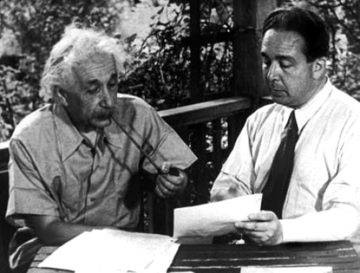
Now Szilard leaned on his friend to communicate an urgent message to President Franklin Roosevelt. “Extremely powerful bombs of a new type may be constructed…a single bomb of this type, carried by boat and exploded in a port, might well destroy the whole port together with some of the surrounding territory”, said the letter. It ominously pointed out that Germany had both the material and the intellectual resources to build such bombs and the Germans had actually halted sales of uranium from mines in occupied Czechoslovakia. Szilard drafted the letter and drove to Einstein’s summer cottage in Long Island in August, 1939. Einstein was astonished when Szilard told him about fission, agreeing right away to sign the letter. Assigned as courier was an economist named Alexander Sachs who had FDR’s ear.
About a month later, Hitler launched the Second World War by attacking Poland. On September 1, the day of his blitzkrieg assault on the unfortunate country, two papers appeared in the Physical Review. One was a paper by Oppenheimer and his student Hartland Snyder detailing for the first time the enigmatic objects that we now call black holes. The second was a paper by Bohr and Wheeler detailing the mechanism of nuclear fission and pointing out, among other things, the primacy of the minor isotope of uranium, uranium-235, for fission. For obvious reasons, world events ensured that the second was highlighted and the first consigned to the sidelines for the next two decades. Bohr and Wheeler imagined the nucleus as hovering on the edge of stability and worked out how a single neutron could make it wobble and fall over on one side, resulting in its breakage. With Bohr’s paper fission was on a firm scientific foundation. But with Szilard and Einstein’s letter, fission had gotten an uncertain political start; while FDR realized the importance of the discovery when Sachs brought him the Szilard-Einstein letter, its practical harnessing was still a distant dream, and world events overtook its urgency in his mind anyway. A committee called the Uranium Committee was formed and, hamstrung by lack of urgency and funding, limped along for the next year while the United States remained officially neutral and European émigré physicists like Einstein, Fermi, Szilard and Teller who knew the dangers of Nazism firsthand fumed and lobbied and cooled their heels.

A startling package from Britain changed everything. By the spring of 1940, Otto Frisch had repaired to Britain from Sweden and had become a research associate at the University of Birmingham. Frisch joined forces with Rudolf Peierls, another émigré from Germany who had obtained his Ph.D. with Werner Heisenberg and was well aware of German prowess in the field. Both were working for Mark Oliphant, an Australian-born physicist who had been a protege of Rutherford. Unlike the United States, Britain which was facing imminent potential invasion by the Nazis had found it a matter of mortal urgency to conduct war-related research. Their top priority was radar which, given the proximity of Britain’s coastline to Nazi bombers, could make the difference between freedom and bondage for Britons. Until they became naturalized citizens, Oliphant could only ask Frisch and Peierls roundabout questions about radar or nuclear energy. But once the two were naturalized, they asked themselves a simple question: what would be the so-called critical mass of uranium-235 needed for a bomb? It had been clear that one needed to assemble a certain amount of uranium to ensure that there were enough neutrons to fission all the nuclei, but while the amount had previously been assumed to be on the order of tons, Frisch and Peierls found out through a relatively simple calculation that it was just a few kilograms. While separating the rare uranium-235 (which exists to the extent of only 0.7% in natural uranium) from the abundant uranium-238 would still be very challenging, there was a world of difference between separating kilograms and separating tons.
Britain was desperate to court the attention and aid of the United States; radar and nuclear research seemed to be the keys to the kingdom. The so-called “Frisch-Peierls memorandum” made it across the Atlantic along with a key radar innovation called the cavity magnetron that could greatly amplify radar signals; radar research in the United States was being inaugurated at MIT. Receipt of this package of great importance accelerated both the radar and the nuclear programs. It brought to the fore a remarkable constellation of scientist-administrators who would become models for the post-war ascendency of American science. These included Harvard president James Conant and MIT engineer Vannevar Bush, both canny, efficient administrators as well as first-rate scientists and engineers. Bush would report directly to FDR and head the Office of Scientific Research and Development; Conant would head the National Defense Research Committee. The group also included Arthur Compton from the University of Chicago and Ernest Lawrence. By then, Lawrence with his big cyclotrons which promised separation of the two uranium isotopes and his entrepreneurial ability for raising millions of dollars for his research had established himself in the forefront of the leaders of American science; his credentials had been burnished by a Nobel Prize in 1939.
Left out was Robert Oppenheimer.
After his lightning-fast realization of the possibility of fission in front of Luis Alvarez in 1939, Oppenheimer had been on the sidelines. He felt a smoldering fury about the treatment of the Jews in Germany, including some family members who he had helped get out in time. His marriage to Kitty had brought a semblance of stability to his life; in 1941 the couple moved to a handsome new house at 1 Eagle Hill in Kensington. He had become a doting father; Peter Oppenheimer was born the same year.
Oppenheimer still served as a father figure to an intimate brood of students who were brilliant and decidedly left-leaning – they included David Bohm, Philip Morrison, Joseph Weinberg and David Hawkins. All of them were devoted to Oppenheimer and spoke very highly of him – as an indicator of things to come, Hawkins would speak of Oppenheimer’s silver tongue and powers of persuasion as a politician – but all of them in one way or another would cause trouble for him. With these students Oppenheimer attended and hosted meetings, organizing and raising money for various causes. Part of his activities included trying to recruit students for a union at the Berkeley radiation lab – Lawrence’s domain. Beginning in 1941, Lawrence – whose political sensibilities were conservative – became interested in making Oppenheimer a part of the discussions – “Oppenheimer has important new ideas; I have a great deal of confidence in him”, he wrote Compton – but was put off by Oppenheimer’s political activism. He asked his friend several times to shelve his politics for the sake of the war. In October, 1941, Lawrence convinced Bush, Conant and the others to include Oppenheimer in a secret meeting in Schenectady, NY, where he presented his calculations that put an upper bound on the critical mass of uranium-235 at a hundred kilograms.
Everything changed on December 7, 1941 with the attack on Pearl Harbor. America which had been shackled internally by politics and externally by want of a common enemy could suddenly free herself and bring her combined military, political, economic and industrial might to bear on defeating Germany and Japan. The previous evening, Oppenheimer had attended a fundraiser for the Spanish Civil War. After hearing of Pearl Harbor, he decided that “I had had enough of the Spanish cause, and that there were other, more pressing crises in the world.” He was finally at the center.
In January, 1942, Oppenheimer was put in charge of theoretical calculations for the project, attaining the exalted title of “coordinator of rapid rupture”. He immediately recruited his close student and friend Robert Serber to be his right-hand man. Serber who was a physicist’s physicist had worked as Oppenheimer’s assistant at Berkeley for several years before accepting a position at the University of Illinois; when Oppenheimer had tried to recruit the talented physicist for the Berkeley physics department faculty, Raymond Birge who was the chairman blankly told him that “one Jew in the department is enough.” Oppenheimer and Serber began to organize a group of experts who could help make inroads into the critical aspects of building a fission bomb.
Foremost on Oppenheimer’s list was Hans Bethe of Cornell University. By 1942 Bethe had demonstrated himself as one of the most important theoretical physicists in the world. After being forced to leave Germany in 1935, he had become deeply attached to his adopted country and made Cornell one of the leading centers for physics. Bethe’s three-piece review article on nuclear physics was called “Bethe’s Bible” and was essential reading. He would become one of only a handful of 20th century physicists – only Enrico Fermi and the Russian Lev Landau really come to mind – who had mastery over all of theoretical physics. Like Oppenheimer he had been desperate to aid the war effort, but because he was still technically not a citizen he could not directly contribute. Instead with Edward Teller he had published a detailed study of shock waves, which ironically was promptly classified by the military so that its original authors could not access it.
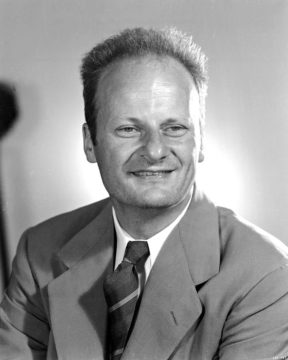
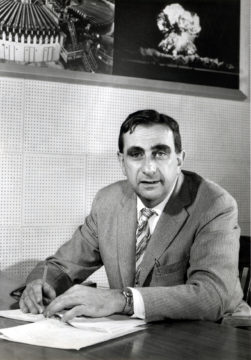
Teller was another of the scientists Oppenheimer wanted to enlist; little did either man know then that their entangled lives would be immensely consequential and tragic for both. Teller was one of Bethe’s best friends and had been best man at the German physicist’s wedding. He was part of a Hungarian-born contingent of Jewish scientists known for their brilliance and versatility, a contingent nicknamed “The Martians” that included John von Neumann, Szilard and Eugene Wigner. Teller was creative, volatile and tempestuous, a lover of classical music who played the piano competently. With his fellow Hungarians he had come of age in the chaos of war and the successive communist and fascist revolutions that rocked Hungary. He had studied with Werner Heisenberg and, like other European Jewish scientists such as Einstein and Bethe, had been forced to flee Europe when Hitler came to power. Because of his twin experiences with communism and Nazism, he passionately hated both political systems.
Along with Serber, Bethe and Teller, Oppenheimer invited a few other physicists to a summer study at Berkeley that would explore the feasibility of a bomb; he called his physicists “the luminaries”. The men met in Oppenheimer’s office in Le Conte Hall. Since they were in new territory, their starting point was an explosion of a ship in Halifax, Nova Scotia in 1917; with a yield equivalent to 2.9 kilotons of TNT, it remains the largest non-nuclear explosion in history. The physicists used the Halifax data as a springboard for gauging the characteristics of the explosion of a fission bomb and calculated that the weapon could easily be several times bigger in its impact. They then turned to the actual design of the bomb.
The luminaries very quickly appreciated the speed and reach of Oppenheimer’s mind and especially his facility in directing a group of his peers. “As chairman”, Teller later grudgingly wrote, “Oppenheimer showed a refined, sure, informal touch. I don’t know how he had acquired this facility for handling people. Those who knew him well were really surprised.” Bethe, a man who could easily run circles around other physicists with his sheer intellectual stamina and unsurpassed knowledge of physics, was even more impressed: “His grasp of problems was immediate – he could often understand an entire problem after he had heard a single sentence.” As the discussion went on, Bethe could see “firsthand the tremendous intellectual power of Oppenheimer who was the unquestioned leader of our group…the intellectual experience was unforgettable.” Perhaps a quip by Charlie Lauritsen, an experimental colleague and friend of Oppenheimer’s, sums up the awe that he evoked: “This man was incredible; he gave you the answer before you had a chance to ask the question.” But Bethe also astutely captured an obvious problem with Oppenheimer’s remarkable facility for getting ahead of the game, one that was to give him no little grief: “Incidentally, one of the difficulties he had in dealing with people was that he expected them to have the same facility.”
The Berkeley discussions which otherwise went on smoothly were derailed by a single episode which indicates how much of virgin territory the field was. Looking at the roster of nuclear reactions a fission bomb would involve and their attendant energy releases, the creative Teller brought up the possibility of the bomb igniting the atmosphere and extinguishing life on the planet. The question stopped the physicists in their tracks. Oppenheimer took it seriously enough that he decided to travel immediately to Lake Michigan where Arthur Compton was vacationing. “I’ll never forget that morning”, Compton later dramatically recalled, “I drove Oppenheimer from the railroad station down to the beach looking out over the peaceful lake. There I listened to his story…Was there really a chance that an atomic bomb would trigger the explosion of the nitrogen in the atmosphere or the hydrogen in the ocean? This would be the ultimate catastrophe. Better to accept the slavery of the Nazis than to run a chance of drawing the final curtain on mankind.”
“I didn’t believe it from the first minute”, was Bethe’s scornful reaction to Teller’s warning. “I very soon found some unjustified assumptions in Teller’s calculations which made such a result extremely unlikely, to say the least. Teller was soon persuaded by my arguments.” Bethe who knew reaction cross sections and rates by heart found out that there was a near-zero probability that a nuclear reaction could propagate in the atmosphere and ignite it, mostly because the energy losses would almost certainly exceed the energy gains (this calculation by Bethe mirrored a recurring pattern seen in his and Teller’s relationship during their long lives; time and time again when Teller would bring up an idea that either sounded too optimistic or too outlandish, the methodical Bethe would demolish the idea by doing detailed calculations).
The Berkeley conference made clear Oppenheimer’s mastery of all details of the project and his ability to lead a group of highly accomplished scientists. By the fall of 1942, it was clear that he could be seriously considered as one of the leaders of a project to build a fission bomb. All that remained was for someone to formally anoint him. That someone was a man who had just received a piece of news that had made him very unhappy. He was a colonel in the army, and his name was Leslie Groves.
Sources:
1. Richard Rhodes, “The Making of the Atomic Bomb”, 1986
2. Kai Bird and Martin Sherwin, “American Prometheus: The Triumph and Tragedy of Robert Oppenheimer”, 2005
3. Silvan Schweber, “In the Shadow of the Bomb: Oppenheimer, Bethe and the Moral Responsibility of the Scientist:, 2000
4. Post: The Enduring Legacy of Leo Szilard, Father of the Atomic Age, 2015
5. Post: Celebrating the 1939 Leo Szilard letter to FDR and Setting the Record Straight, 2014
